
This page is part of © FOTW Flags Of The World website
Universidad Autónoma de Santo Domingo - Faculdad (Dominican Republic)
Autonomous University of Santo Domingo - Faculty
Last modified: 2015-05-09 by randy young
Keywords: dominican republic | autonomous university of santo domingo | universidad autónoma de santo domingo | bicolor: horizontal (blue-white) | faculty | faculdad | faculty of humanities | faculdad de humanidades | faculty |
Links: FOTW homepage |
search |
disclaimer and copyright |
write us |
mirrors

image by Ivan Sache, 5 December 2014
See also:
The nine faculties that form UASD have their own flags, similar to the UASD flag (horizontally divided indigo blue-white) but with their own emblem in the middle instead of the university's emblem. In some official events, the flags of the faculties are placed on the podium together with the flags of Dominican Republic and UASD.
The flags are best seen in a photo taken during the graduation ceremony held on 24 August 2014 at UASD-Higüey. From right to left (according to the order of presentation of the faculties on the UASD website):
- Faculty of Humanities
- Faculty of Sciences (concealed by the national flag)
- Faculty of Economical and Social Sciences
- Faculty of Juridical and Political Sciences
- Faculty of Engineering and Architecture
- Faculty of Health Sciences
- Faculty of Agronomic and Veterinary Sciences
- Faculty of Art
- Faculty of Education Sciences
The flag of the Faculty of Sciences is visible on a video footage.
The flags are also displayed during the opening ceremony of the Tony Barreiro Games.
Ivan Sache, 6 December 2014

image by Ivan Sache, 6 December 2014
The Faculty of Philosophy existed from 1528 to 1823, but was, unfortunately, omitted, when the university was re-activated in 1882. Re-established on 19 November 1914, it was suppressed again on 5 April 1918 by the military government. The Faculty of Philosophy, Literature and History was established by Law No. 1,398 of 21 October 1937. Renamed for a while Faculty of Philosophy, it was again renamed Faculty of Philosophy, Science and Education by Law No. 4,864 in February 1958, and Faculty of Philosophy and Education by Law No. 5,008 of 2 December 1958. The Faculty of Humanities was eventually established by the university's Statutes adopted in 1966.
The coat of arms of the Faculty of Humanities is divided into three parts. The upper left part is charged with a purple letter "H" (for "Humanidades"). The upper right part is purple. The lower half is charged with an armless bust and a quill over an open book, symbolizing art and literature.
Ivan Sache, 6 December 2014

image by Ivan Sache, 6 December 2014
The Faculty of Sciences was established by the university 's Statutes adopted in 1966, to replace the Faculty of Pharmacy and Chemical Sciences, which had been established on 19 November 1914.
The coat of arms of the Faculty of Sciences is horizontally divided into two parts. The upper half is white with the light blue letters "FC", for "Faculdad de Ciencias," while the lower field is light blue with a white atom.
Ivan Sache, 6 December 2014
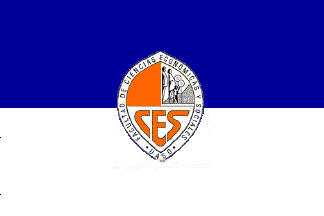
image by Ivan Sache, 6 December 2014
The Faculty of Economics and Commerce was established by Law No. 4,412 of 24 March 1956, as the merger of the Faculties of Economy and of Commerce, which had been established by Law No. 1,398 of 21 October 1937. The Faculty of Economics, Finance and Commerce was established by Law No. 4,439 of 4 May 1956 and renamed Faculty of Economical Sciences by Law No. 5,130 of 1959. The Faculty of Economical and Social Sciences was eventually established by the university 's Statutes adopted in 1966.
The coat of arms of the Faculty of Economical and Social Sciences is divided into three parts. The first part is plain orange. The second part features an allegory of population and statistics. The lower half is white with the orange letters "CES for "Ciencias Económicas y Sociales."
Ivan Sache, 6 December 2014
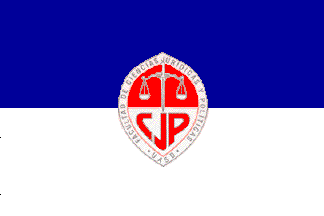
image by Ivan Sache, 6 December 2014
The Faculty of Jurisprudence was established in 1866 and renamed Faculty of Law on 7 October 1875. The Faculty of Law and Political Sciences was established on 16 November 1914. The Faculty of Juridical Sciences was established by the university 's Statutes adopted in 1966, to be renamed Faculty of Juridical and Political Sciences in 1971.
The coat of arms of the Faculty of Juridical and Political Sciences is horizontally divided into two parts. The upper half is vermilion red with an allegory of justice, made of a sword superimposed to a pair of scales, while the lower half is white with the red letters "CJP" for "Ciencias Jurídicas y Políticas."
Ivan Sache, 6 December 2014
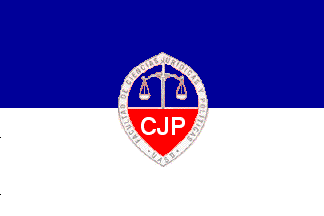
image by Ivan Sache, 6 December 2014
The faculty also uses in official events a flag with a different coat of arms: the upper half of the shield is blue with the sword and scales represented in white, while the lower half is red with the white letters "CJP."
Ivan Sache, 6 December 2014
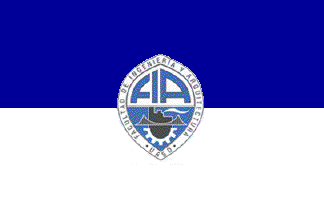
image by Ivan Sache, 6 December 2014
The coat of arms of the Faculty of Engineering and Architecture is horizontally divided into two parts. The upper half is white with the gray blue letters "FIA", for "Faculdad de Ingeniería y Architectura," while the lower half is grey blue with sketchy representations of a bridge, a factory and a cogwheel.
Ivan Sache, 6 December 2014

image by Ivan Sache, 6 December 2014
The Faculty of Medicine existed at the foundation of the university. It was renamed Faculty of Medicine and Life Sciences when the university was re-established on 19 November 1914. Law No. 1,398 of 21 October 1937 shortened its name to Faculty of Medicine. The Faculty of Medical Sciences was eventually established by the university 's Statutes adopted in 1966, to be renamed Faculty of Health Sciences in 1970.
The coat of arms of the Faculty of Health Sciences is horizontally divided into two parts. The upper half is yellow with a white snake twirled around a brown staff, while the lower half is white with the letters "CS", for "Ciencias de la Salud."
Ivan Sache, 6 December 2014
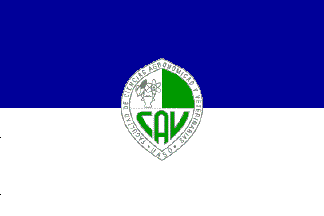
image by Ivan Sache, 6 December 2014
The Faculty of Agronomy and Veterinary was established by Law No. 1,398 of 21 October 1937, and renamed Faculty of Agronomic and Veterinary Sciences on 9 December 1964.
The coat of arms of the Faculty of Agronomic and Veterinary Sciences is divided into three parts. The first part is white with an allegory featuring a maize cob, a bovine's head and an atom. The second part is green. The lower half is white with the green letters "CAV" for "Ciencias Agronómicas y Veterinarias."
Ivan Sache, 6 December 2014
The Faculty of Art, which already existed at the foundation of the university, was re-established by Resolution No. 76 of 16 May 2001.
The coat of arms of the Faculty of Art was designed by the architect Fernando Suncar, then Director of the Faculty, the visual artist and professor Julián Amado Ortiz, and the student Yajahira Altagracia Maríñez Lara.
The emblem is organized around the icon of Alma Mater, described in Article 136 of the UASD Statutes as the representation "of the Nourishing Mother, symbol of the source of learning that drenches people to feed them with the scientific knowledge elaborated, transmitted and divulged by the institution". Coloured in white, the Alma Mater represents the source of learning, as well as virginity and purity of knowledge. She holds in her left hand the UASD coat of arms and is sitting on an open book. The Faculty of Arts is the sole faculty to feature a symbolic figure on its coat of arms. The representation of the Alma Mater slightly differs from the official statue designed by Benjamín Saúl (1924-1980), a noted Spanish sculptor who spent most of his life in El Salvador.
The open book represents the abundance of knowledge as food, open as a sign of receptivity. It also represents the book of life, the learning process, revelation and the spirit of knowledge. It symbolizes science and knowledge that feed the different generations through teaching and education provided by the institution. The cover of the book forms two big wings, symbols of the merging knowledge and of destiny. They represent both the protecting wings of the spirit and spirituality as a way to transcendency. The book and the wings together represent substance and creative principle.
The wings symbolize liberty and the wings of imagination. They also represents the power of communication and connection of space and time, between the spiritual and the material realms. The spread wings represent protection provided by learning and knowledge. Four wings - two big and two smaller - are indeed represented, as a symbol of vigilance and perpetual motion.
The Alma Mater is crowned by an element made of basic figures arranged concentrically, as a symbol of universality, placed in the order of the elements in the cosmos and the inhabited world. They represent the divine, human and natural dimensions, the human being being the mediator between the natural and spiritual worlds.
The circle is a universal symbol representing the cosmos' totality and integrality, like the sky, natural and perfect. It is the outer shape that frames all elements, representing everything that can be contained inside it and a cycle completion.
The square represents living on earth. Combined with the circle, the square represents the integration of the spiritual and material dimensions, or the transformation of spirit. The intersections between the circle and the square form four segments representing the earth's quarters and indicating the cardinal directions. A secondary quarter seems to rotate, also arranged concentrically, recalling a rhombus reiterating the creative principle.
The triangles are reiterated inside the square, emphasizing the triple nature of the universe: the sky, the earth and the human being, or the eternity connected to the ultimate figure formed by the intersection, a star.
The eight-pointed stars irradiate vectorial lines merging into the triangles; They represent the supreme power as the union of the contraries or the perfect balance between complementary forces. The oval border of the shield is charged with 100 equidistant disks associated with the multiples disciplines of knowledge taught at UASD and with the interdisciplinary character of art and its incidence on human beings.
The writing "Universidad Autónoma de Santo Domingo, 1538" is separated from "Faculdad" by a circle representing universality; "Faculdad" is separated from "de Artes" by a triangle symbolizing balance; "de Artes" is followed by a square representing completeness and the earth. The cross, borrowed from the UASD coat of arms, confirms the belonging of the faculty to UASD since its early beginning and appears as a focal point and axis of equilibrium of the base of the shield. The writing uses the sans serif face type Gill Sans Ultra Bold.
The pure white colour and the golden yellow background represent light and God's grace, as the origin of everything. White is a symbol of transcendency, illumination, purity and chastity. It is also a symbol of the sacred and divine character of the revealed truth. Yellow is a symbol of wealth and immortality, indicating permanence and perfection. [Source]
On the flag, the border of the coat of arms is similar to the border of the UASD and other faculties' coat of arms, without the ornamentation of the coat of arms prescribed for use on printed material.
Ivan Sache, 6 December 2014

image by Ivan Sache, 6 December 2014
The Faculty of Education Sciences was established on 17 September 2008.
The coat of arms of the Faculty of Education Sciences is divided into three parts. The upper left part is charged with a column representing knowledge. The upper right part is charged with people sitting around a table, representing participation and integration. The lower half is charged with the black letters "FCE" for "Facultad de Ciencias de la Educación." The colour of the faculty is bone white (clear cream), meaning distinction and force.
Ivan Sache, 6 December 2014










